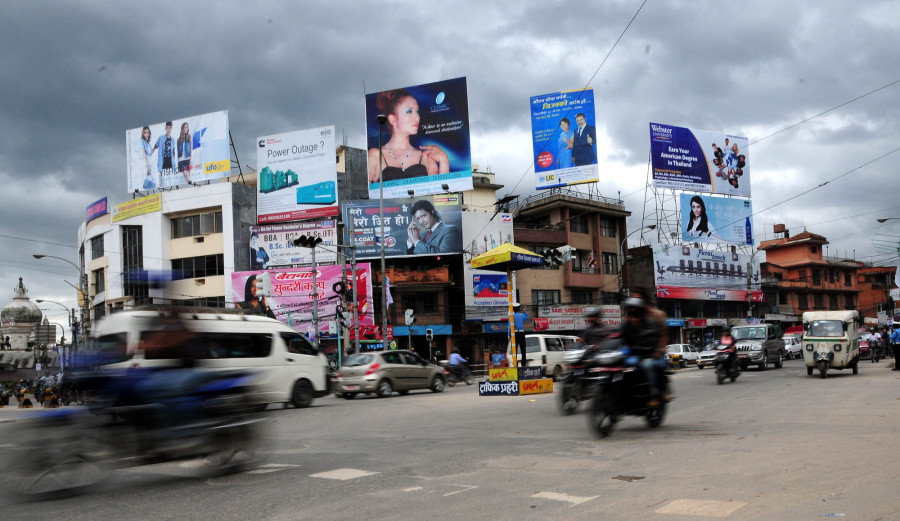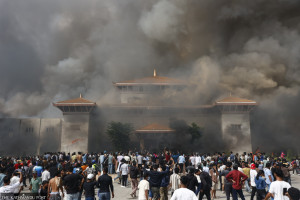Kathmandu
Kathmandu is plastered with hideous hoarding boards and the city can't do anything about them
Kathmandu Metropolitan City and Lalitpur Metropolitan City regularly launch campaigns to remove billboards, but they never end up executing them.
Chandan Kumar Mandal
As visitors come out of Kathmandu’s Tribhuvan International Airport, two gigantic hoarding boards—one a welcome greeting and the other a cement advert—greet them. The problem with these two hoarding boards placed right across the road from the airport’s main entrance is that they block the majestic view of the Nagarjuna hill on the western side of the Kathmandu Valley.
As you make into the city, unsightly advertisements, pamphlets, movie posters, banners and graffiti continue to line the streets. Haphazardly installed hoarding boards, pamphlets and posters have sullied the aesthetics of the Capital city known for its rich architecture.
The challenge of maintaining the city’s aesthetics is well-known among local authorities. Every year, Kathmandu Metropolitan City and Lalitpur Metropolitan City launch campaigns to remove billboards from various places as part of the city beautification project. These initiatives to rid the city of visual pollution, however, has not yielded much results.
In 2014, the KMC had told the Post that it would resume its campaign to remove hoarding boards from major city centres. Five years later, the same official is again claiming that the authority would remove all these elements of visual pollution—pollution that impacts a person's ability to enjoy a vista.
Senior advocate Padam Bahadur Shrestha, who had filed a writ petition demanding removal all forms of visual pollution, says little has changed in the last few years because the city authorities failed to implement the order of the Supreme Court.
Responding to the petition, the Supreme Court had first issued an interim order to the local authorities and the government to maintain a clean environment in the city. The final verdict on September 2, 2015, ordered the concerned authorities to maintain the civilized appearance of the city and remove the visual pollutants from core city areas.
“Every year, they come up with eyewash like campaigns only to show that they are trying to remove these visual pollutants. They also impose fine, but the problem has remained as it was years ago,” Shrestha told the Post. “The Supreme Court order is itself a law but it is hardly implemented.”
Unhappy with the presence of visual pollutants around the city and poor implementation of the court decision, Shrestha had filed four complaints at the Judgment Execution Directorate against the Prime Minister’s Office and the cities of Kathmandu and Lalitpur.
“Our demand was not to fine the polluters but to completely remove the hoarding boards,” Shrestha said. “Now, I am thinking of filing a contempt of court case against the government and the city authorities.”
Any posters and pamphlets pasted at public places are solid waste under the Solid Waste Management Act, 2011. As per the Act, these pamphlets and posters should be removed and collected by the city authorities.
For Kathmandu Valley, which is already dealing with problems of waste management and pollution, restoring and recovering the vanishing aesthetics from the ravages of modernity is a major challenge, say urban planners.
“Cities like Kathmandu, which is known for its glorious heritage and medieval and Malla-era architecture, must maintain its aesthetics by removing all these distortions,” Suman Meher Shrestha, an urban planner told the Post. “After the earthquake, some of these hoarding boards, inappropriately placed, were removed due to threats. But it was not enough.”
Suman is of the view that placement of advertisements should be aesthetically and visually soothing and easily blend with the surroundings, without distorting natural sites. Wood-carved signage at protected parks, he says, can be the best example of blending advertisements, greeting messages and promotional materials with their surrounding locations.
“But we see huge hoarding boards and neon lights at the top of commercial buildings only causing visual pollution,” said Suman. “There should be standardised guidelines mentioning sizes, eye level, paint, bordering, glow, and other design aspects as well as the placement of signage.”
According to advocate Shrestha and urban planner Suman, the city authorities and the government should immediately do something to remove visual distractions, as the country is gearing up to celebrate the ‘Visit Nepal 2020’.
“Not a single tourist comes here to see our billboards, neon lights and skyscrapers. For that they can go to Times Square or any major cities of the world,” said Suman. “They visit Nepal to see our heritage and nature. We have to make sure they enjoy these sites without any distortions.”




 10.12°C Kathmandu
10.12°C Kathmandu











